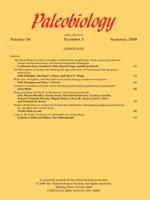Multivariate analysis of shell characters and quantification of morphological diversity (morphospace occupation and disparity) are used here to investigate the modes of morphological diversification of ammonites. We define five events in early cardioceratid history that connect geographical changes causing emigration or immigration phases with biodiversity dynamics: (1) the initial colonization of the Arctic Basin by the Cardioceratidae at the end of the Bajocian, Middle Jurassic; (2) the first appearance of the Kosmoceratidae clade in the Boreal Realm during the Bathonian; (3) the ensuing expansion phase of this clade in the Boreal Realm; (4) the first phase of migration of the Cardioceratidae (early Callovian) through Eastern Europe, Western Britain and the Yukon corridor; and (5) the second unrelated migration phase in the Western Interior only. Analysis of spatial occupation shows that acquisition of this field occurs essentially by replacement or subdivision of preexisting peaks of occupation. These replacements seem to follow different patterns: progressive trend, saturation, iteration, and apparent preferential extinction. We describe these patterns and suggest different factors that may have shaped them, including a morphological differentiation that has been interpreted by various authors as sexual dimorphism. Another factor that could cause disparity modification is fluctuations in the ammonites' proximal environment. The effect of immigrating faunas is a third (and preponderant) factor that is prominent in the studied example: immigration phases of the Cardioceratidae lead to increased morphological diversity, whereas the spread of nonindigenous species reduces it and is contemporaneous with a morphological shift in the native clade. We thus demonstrate here that geographical constraints play a significant role in the expression of innovation and may be seen as a major factor in macroevolutionary dynamics.
How to translate text using browser tools
1 January 2005
Faunal invasions as a source of morphological constraints and innovations? The diversification of the early Cardioceratidae (Ammonoidea; Middle Jurassic)
Nicolas Navarro,
Pascal Neige,
Didier Marchand
ACCESS THE FULL ARTICLE

Paleobiology
Vol. 31 • No. 1
January 2005
Vol. 31 • No. 1
January 2005




